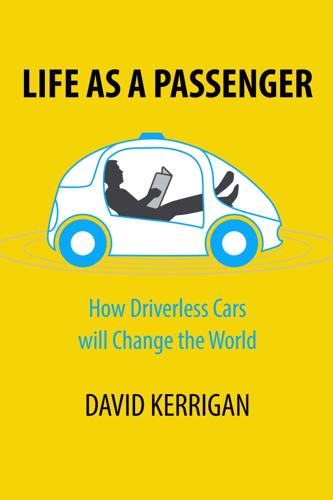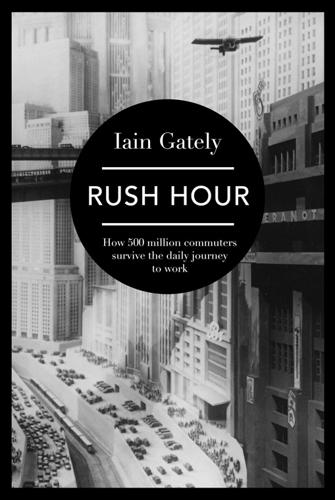
Supertall: How the World's Tallest Buildings Are Reshaping Our Cities and Our Lives
by
Stefan Al
Published 11 Apr 2022
With autonomous vehicles, hyperloops, and aerial ridesharing in the near future, we may be up for a wild ride! Plus, along with it, land that was previously less desirable will become the development hot spots of tomorrow. New mobility systems will change our cities and buildings once again. In 1994, Italian physicist Cesare Marchetti described a principle, now known as “Marchetti’s constant.” He found that, in general, people are willing to commute for about one hour a day, or a half-hour one way. Since Neolithic times, people kept the average time spent for travel the same, even when transportation advances allowed them to increase their distance. This idea has had far-reaching effects on our cities.
…
This may lead to the explosive growth of metropolitan areas. You could commute from your office in downtown Los Angeles to Las Vegas, where prices are lower, and live in a bigger home. The race will be on for the first hyperloop-integrated skyscraper. Autonomous vehicles (AVs) could desensitize people to distance, possibly lengthening Marchetti’s “constant” of commuting time. Without having to attend to the wheel, you can now sleep in your car, or conduct online meetings there. Perhaps you can live a little farther away and buy a cheaper home? In other words, cities will increasingly sprawl out. The increase of telecommuting, accelerated by COVID-19, may have a similar impact.
…
While hyperloops are faster, they probably won’t come close to the transport efficiency of the good old subway. Hyperloops can carry 3,360 passengers an hour.29 A single subway can carry more than ten times as many people. (While it might not carry as many people, a hyperloop’s higher speeds would prevent people from otherwise taking a more carbon-intensive ride.) If Marchetti’s constant continues to hold, building new developments around faster forms of mobility may further encroach on untouched land, destroying habitats and threatening ecosystems. But there is another option. Access is a function of proximity and mobility. Instead of focusing on new mobility, we can increase access with proximity, by more densely packing activities or with a larger variety of uses.

Aerotropolis
by
John D. Kasarda
and
Greg Lindsay
Published 2 Jan 2009
When he finished Peachtree Center in 1976, the result was a hermetically sealed “Center” central to nothing except its clones elsewhere. He had built the urban equivalent of a hub, profitable and infinitely repeatable anywhere. And with that, his LEGO-block approach became the reigning vernacular in Airworld’s peculiar geography of nowhere. Kasarda’s Law and Marchetti’s Constant It wasn’t supposed to be this way. Technology was going to ground us by linking and shrinking the world, and in doing so set us free. The world would flatten. Road warriors would beat their platinum medallions into plowshares. It hasn’t happened. For twenty years, we’ve heard how e-mail and videoconferencing— relabeled “telepresence”—would eliminate the need for cross-country meetings.
…
But as horse trams came along, followed by electric trams, then subways, and finally cars, the city’s periphery raced away from its Enlightenment-era core. Berlin’s diameter was effectively ten times wider in 1950 than it was 150 years earlier, yet it still took only an hour to traverse. The rule has since been dubbed Marchetti’s Constant. Marchetti contended that transportation, not communications, was the “unifying principle of the world.” Ratifying Kasarda’s Law, he attested that the “so-called explosion in communication during the last 20 years did not dent transportation expansion; on the other hand, they tend to move together.”
…
A group called the Future Forum predicted there will be 1.5 million people working in the U.K. but living overseas by 2016, commuting daily or weekly between London and Barcelona, Marrakech, Dubrovnik, Verona, Palma, Pula, and Valencia. Dallas residents know the drill. Started here in 1973, Southwest Airlines was the template for Ryanair and every low-fare carrier since. The combination of deregulation, cheap tickets, and gratuitous expense accounts has brought air travel well within range of Marchetti’s Constant, hence consultant expresses and Jim Tam’s perambulating across Texas. Consider Angela Kim, who commutes from Houston to Dallas every Tuesday to babysit her grandson for a few days while her daughter the physician pulls back-to-back shifts for her residency. Occasionally she lands, scoops him up at the curb, and boards the next 250-mile, fifty-five-minute flight back to Dallas.

Scale: The Universal Laws of Growth, Innovation, Sustainability, and the Pace of Life in Organisms, Cities, Economies, and Companies
by
Geoffrey West
Published 15 May 2017
This surprising observation of the approximately one-hour invariant that communal human beings have spent traveling each day, whether they lived in ancient Rome, a medieval town, a Greek village, or twentieth-century New York, has become known as Marchetti’s constant, even though it was originally discovered by Zahavi. As a rough guide it clearly has important implications for the design and structure of cities. As planners begin to design green carless communities and as more cities ban automobiles from their centers, understanding and implementing the implied constraints of Marchetti’s constant becomes an important consideration for maintaining the functionality of the city. 4. THE INCREASING PACE OF WALKING Zahavi and Marchetti presumed that for a given mode of transportation, such as walking or driving, travel speed did not change with city size.
…
., 48–49 life expectancy (life span), 6, 11–12, 183–94, 457n estimated gain in, if given disease was cured, 193, 193–94 human mortality curve, 189–90, 192, 192–94, 193 human survivorship curves, 189–94, 191, 192 maximum, 6, 24, 188–94, 202–3 temperature dependence of, 175, 176, 177, 203–4 life extension, 6, 183–94, 203–7 body temperature and, 203–4 caloric restriction and, 205–7, 206 heartbeats and pace of life, 204–5 Limehouse (London), 224–26 Limits to Growth, The (Meadows), 231–32 linear thinking, 17–18, 44–45, 72, 157 links and social networks, 297–98, 298, 319–20 Liverpool, walking lanes, 335–36, 336 Living Earth Simulator, 271 Lobo, José, 274–75, 356, 364, 386 logarithms, 26, 47–48, 49 London, 222–26, 267–68 garden cities, 255 growth curve, 376 Longevity Prize, 184 Los Alamos National Laboratory, 83–84, 106, 274, 405, 434, 435 Los Angeles, 17–18, 251, 310 growth curve, 377 infrastructure networks, 252 Lösch, August, 290 Lower Manhattan Expressway, 260 LSD, 52–54 MacBook Air, 439, 445 machine learning, 443–44 macroecology, 105 magic number four, 6, 117 self-similarity and origin of, 126–30 universality and, 93–99 maintenance expenses, 391–93 Malthus, Thomas Robert, 227–30, 287, 414–15, 416, 423 Malthusians, 227–30, 414–15 mammals. See animals Manchester, England, 223–24 Mandelbrot, Benoit, 130–31, 132, 138–45, 152, 364 Mandelbrot set, 143–44 manufacturing, 211 Marchetti, Cesare, 333–35 Marchetti’s constant, 334–35 market capitalization, 379, 389–90 market share, 408–9 Marx, Karl, 228, 332 Masdar (Abu Dhabi), 256, 258, 299 Mathematical Principles of Natural Philosophy (Newton), 181 mathematics, 8 biology and, 85–86, 87 Euclidean geometry, 130–31, 141–42 matryoshka, 128 maximal Krogh radius, 160 maximum life span, 6, 188–94, 202–3 maximum size of animals, 158–63 Maxwell, James Clerk, 109, 115, 428 McCarthy, Cormac, 425 McKinsey & Company, 404, 405 McMahon, Thomas, 198 Mead, Margaret, 239 Meadows, Dennis, 231–32 measurement process, 135–41 mechanical constraints, 122, 158–63 mechanistic theory, 12, 85, 111–12, 144, 145, 182, 408 Medawar, Peter, 86 medical research, 52–55 Medical Research Council Unit (MRCU), 437 medicine, scaling in, 16, 51–57 megacities, 7, 215, 223–24, 267–68 Meier, Paul, 403 mergers and acquisitions, 33, 403–4 survivorship curves, 396–97, 399 metabolic energy emergent laws and hierarchy of life, 99–103 growth and, 165–66 metabolic rate, 13, 18–19, 124–26, 201, 234 of animals, 2, 2n, 3, 13, 18–19, 25–26, 91–92, 285–86 of average human, 88–89 of bacteria and cells, 93, 94, 96 of companies, 391–92 definition of, 13 Kleiber’s law and, 26–27, 90–93, 117, 145 in mammals, plants, and trees, 18–19, 118–22 natural selection and, 88–90, 151 scaling of, 90–91, 173 metabolic theory of ecology (MTE), 115–16, 173–78, 203–4 metabolism of cities, 371–78 energy, and entropy, 12–15 social, 13, 373–74, 415 Metabolism (architecture), 247–48 metaphysics, 179–80 Metropolitan Statistical Areas (MSAs), 356, 462n Mexico City, growth curve, 375 mice, 6, 12, 16, 52, 114 caloric restriction and survival curves, 205, 206 Milgram, Stanley, 296–97, 301–4 Milgram experiment, 301–2 Milky Way, 79 Millennium Bridge (London), 298–300 minimum size of animals, 155–58 mitochondria, 100–102, 101, 113 mobile phone data, as detector of human behavior, 337–45, 351–52, 439 modeling, 62–63 modeling theory, 35, 71–75 Modena, Italy, 249 momentum, 20–21 Moore, James, 249 mortality.

Life as a Passenger: How Driverless Cars Will Change the World
by
David Kerrigan
Published 18 Jun 2017
The lack of road safety also costs up to 5 percent of countries’ GDP, mostly affecting the poorest ones.[316] Most developing countries are still far from being as car-centric as the developed world. City travel is still mostly composed of walking, bicycling and public transport, much more in line with Marchetti’s constant. It is probably preferable if these cities do not replicate the urban mistakes of others, as to multiply them on the scale of Mexico City or Rio would not be feasible. The driverless car might help save developing countries from ever having to replicate the car-centric infrastructure that has emerged in most western cities.

Rush Hour: How 500 Million Commuters Survive the Daily Journey to Work
by
Iain Gately
Published 6 Nov 2014
The similarity in daily travel time between such radically different lifestyles inspired Cesare Marchetti, the Venetian theoretical physicist, to suggest that there was a ‘quintessential unity of travelling instincts around the world’ and that this unity resulted in a fixed ‘travel time budget’ that he named after himself as Marchetti’s Constant. He tested his theory against a variety of cultures past and present and decided that it has shaped our behaviour since the dawn of history. The territory associated with ancient Greek villages, for instance, whose inhabitants went about on foot, was about twenty square kilometres, which was about as much as they could manage within their travel time budget, and this pedestrian limit continued to restrict the size of towns and settlements until the Industrial Revolution.